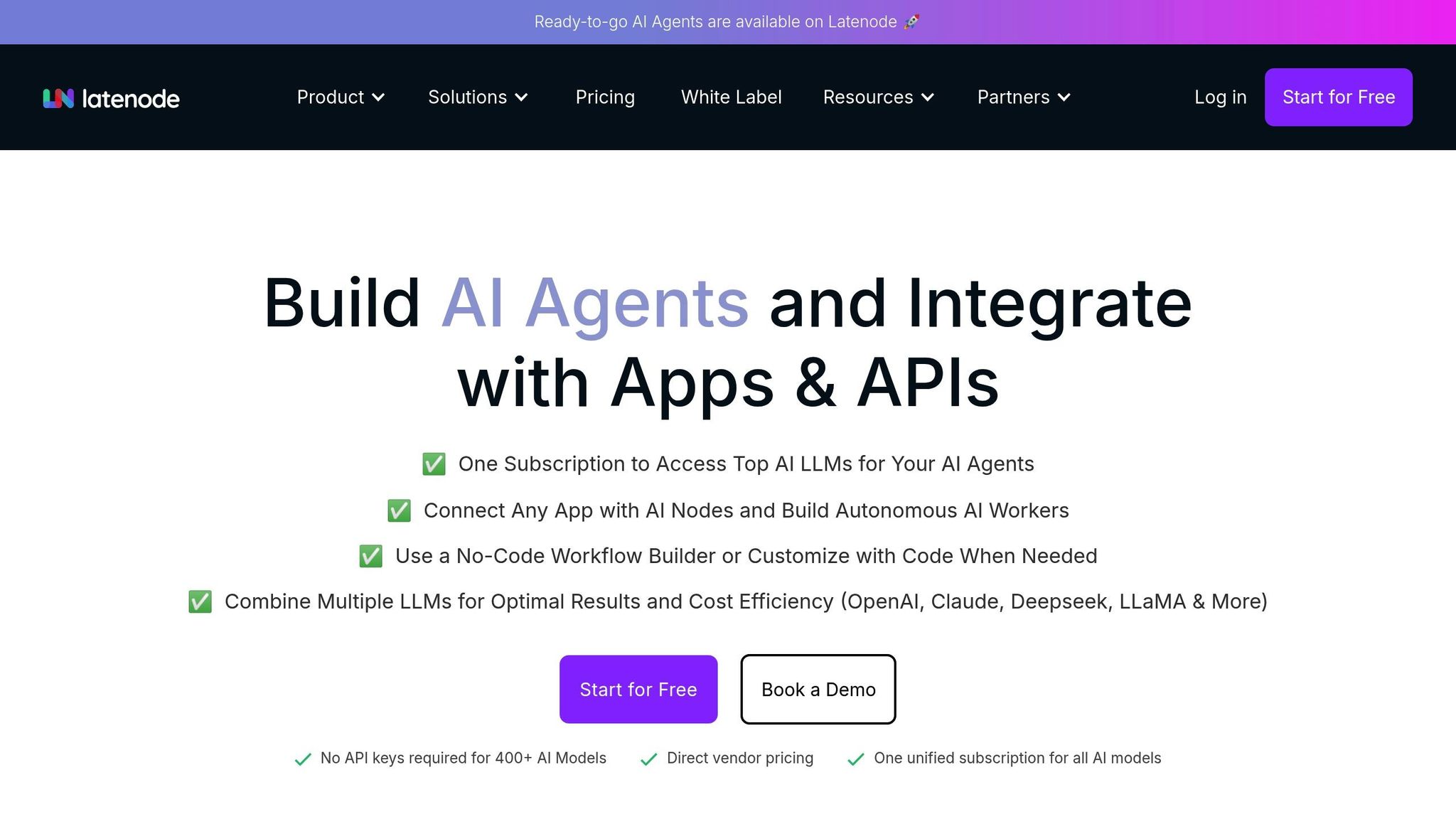


De-identifying personal data is key to protecting privacy, ensuring compliance with laws like HIPAA and CCPA, and enabling safe data use in analytics. Automated systems can now remove identifiers from thousands of records in minutes, reducing risks while keeping data useful for analysis. Techniques like pseudonymization, masking, and generalization help organizations balance privacy with operational needs. For example, replacing a name with "User_1234" allows analysis without revealing identities. Tools like Latenode streamline this process, offering automation workflows that securely handle sensitive data, apply tailored de-identification methods, and maintain compliance seamlessly.
You’ll discover how to apply these methods effectively, safeguard data, and integrate automation tools like Latenode to simplify this complex task.
De-identifying personal data effectively requires selecting a method that aligns with the type of data, compliance standards, and how the information will be used.
Pseudonymization replaces direct identifiers with artificial codes or tokens, allowing data relationships to stay intact for analysis. Unlike full anonymization, this method lets authorized users reverse the process when necessary. For example, a name like "John Smith" could be replaced with "Patient_7429", enabling analysis of treatment history or customer behavior without revealing real identities. To implement pseudonymization, maintain a secure mapping between original identifiers and their pseudonyms.
Data masking, on the other hand, partially obscures sensitive information by substituting characters with symbols or alternative values. For example, a credit card number might appear as "--*-1234", or an email address could be displayed as "j@email.com." This technique allows users to view contextual information without accessing the full data. However, mapping tables and masking keys must be kept secure to prevent unauthorized access.
In some cases, reducing data precision or modifying numeric values can also serve as a de-identification approach.
Generalization involves replacing specific details with broader categories to shield individual identities while retaining useful trends. For instance, an exact age of "34" might be generalized to "30s", or a specific address like "123 Main Street" could be replaced with "Springfield, IL." This method is ideal for analyzing aggregate trends, such as demographic patterns, without exposing individual-level details.
Noise addition introduces random variations to numerical data, ensuring privacy while preserving statistical accuracy. For example, a salary of $75,000 might appear as $74,847 or $75,203 in a de-identified dataset. While individual records lose some precision, the overall dataset remains reliable for analysis, as the random variations balance out. This method is often used in scenarios like risk modeling to analyze spending habits or creditworthiness while protecting personal financial information.
For cases requiring irreversible de-identification, cryptographic methods are often employed.
Hashing converts sensitive data into fixed-length, irreversible strings using cryptographic algorithms. For instance, hashing "john.smith@email.com" with SHA-256 might produce a string like "a665a45920422f9d417e4867efdc4fb8a04a1f3fff1fa07e998e86f7f7a27ae3." Because identical inputs generate the same output, hashing is useful for securely matching records across systems without exposing the original data. However, hashing alone isn’t foolproof, as attackers might exploit rainbow tables or dictionary attacks on common values. Adding a unique salt to the hash enhances security.
Redaction, meanwhile, involves removing sensitive fields entirely, such as Social Security numbers, names, or phone numbers. This method provides the highest level of privacy protection but eliminates the ability to use the data at an individual level. Redaction is most effective when only aggregate statistics are needed, ensuring that no personal details are exposed.
Each de-identification method serves a specific purpose. Pseudonymization and masking are ideal for situations requiring controlled reversibility, generalization and noise addition balance privacy with analytical utility, and hashing supports secure record matching. Redaction, while the most privacy-focused, is best suited for scenarios where individual details are unnecessary. Selecting the appropriate method depends on the balance between privacy needs and data usability.
Automating de-identification processes reduces the risk of manual errors and ensures consistent data protection, even in large-scale operations. To achieve this, you need a platform capable of handling both straightforward data transformations and more intricate privacy rules.

Latenode offers a seamless blend of visual drag-and-drop tools and full JavaScript coding, making it ideal for building complex de-identification workflows. With its visual workflow builder, you can design processes that connect data sources to transformation modules, while custom JavaScript nodes allow for advanced functions like pseudonymization, masking, or hashing.
For instance, you could create a workflow that pulls data from a CRM, applies token replacement using JavaScript, and stores the mapping in Latenode's built-in database. This workflow could dynamically adjust masking rules based on the type of data being processed. By leveraging Latenode's access to over one million NPM packages, you can also integrate specialized cryptographic libraries for secure hashing or encryption.
Latenode's AI capabilities take automation further by identifying sensitive data and triggering appropriate masking methods. For example, by integrating AI models like OpenAI's GPT or Claude, you can classify sensitive information such as Social Security numbers, email addresses, or phone numbers. Once identified, the workflow applies tailored de-identification techniques, ensuring compliance with data protection standards.
Additionally, Latenode’s branching and conditional logic features allow workflows to adapt based on data type or sensitivity. A single automation could apply generalization to demographic data, pseudonymization to customer IDs, and redaction to payment details - all guided by automated classification rules.
After de-identification, securely storing the data is just as critical. Latenode’s built-in database provides a secure environment for both raw and processed data. By separating database tables - for example, into original records, pseudonym mapping, and fully de-identified datasets - you can enhance security while simplifying audits.
The database supports advanced queries and workflow triggers, enabling automated checks to verify de-identification processes. These triggers can activate whenever new customer data is added, ensuring continuous compliance. For organizations managing large datasets, the ability to partition data by date, customer segments, or type allows you to apply tailored de-identification policies while retaining specific information for business purposes.
Latenode’s headless browser automation adds another layer of capability, particularly for handling web-based data sources that lack APIs. This feature allows you to automate interactions with internal dashboards, customer portals, or third-party applications, extracting and redacting personal data directly from web pages.
For example, a workflow could log into a customer support portal, navigate to pages containing sensitive data, and redact personal information during screenshot capture. The sanitized data can then be exported for training or analysis. This approach is especially useful for bulk de-identification tasks, such as processing personal data through web-based tools - from file uploads to result downloads.
To ensure compliance, Latenode can also capture screenshots before and after processing, generate timestamp records, and store them securely in its built-in database. This creates a detailed audit trail that simplifies regulatory documentation and demonstrates adherence to data protection standards.
Ensuring regulatory compliance is essential for effective de-identification efforts to withstand legal scrutiny and avoid costly violations.
In the United States, privacy laws operate at both federal and state levels, each imposing specific requirements for personal data de-identification. One of the most influential frameworks is HIPAA, which sets the standard for healthcare data and has shaped practices across various industries.
HIPAA outlines two primary de-identification methods: Safe Harbor and Expert Determination. The Safe Harbor method involves removing specific identifiers, making it ideal for automated workflows due to its clear, measurable criteria that software can consistently apply. On the other hand, the Expert Determination method allows for more flexibility. It involves a qualified expert analyzing datasets to ensure the risk of re-identification is minimal. This approach is particularly useful for complex datasets where retaining certain identifiers is necessary for analytical purposes, but it demands documented expert assessments and continuous risk evaluations[3][5]. Using Latenode, these methods can be seamlessly integrated into automated workflows, balancing compliance with operational efficiency.
State-level regulations like the CCPA and VCDPA introduce additional requirements[1]. Automated workflows must be adaptable to meet both federal and state mandates simultaneously. For example, with Latenode, you can create workflows that automatically apply different de-identification rules depending on the data type and applicable regulations. A single workflow could process healthcare data according to HIPAA Safe Harbor standards while applying CCPA-compliant pseudonymization to customer records, ensuring compliance across multiple jurisdictions.
To meet stringent regulatory requirements, it’s crucial to implement multiple layers of verification for de-identification processes. Advanced systems today can achieve nearly 99% precision and recall, handling thousands of records in just minutes[3][4].
The first layer of verification is automated validation. With Latenode workflows, you can configure secondary scans after the initial de-identification process, employing different detection algorithms or rule sets to catch any overlooked identifiers. These workflows can flag potential issues, generate compliance reports, and trigger alerts when anomalies are detected. Latenode’s built-in database further enhances this by storing validation results alongside original processing logs, creating the detailed audit trails that regulators require.
Human oversight forms the next layer of verification, addressing edge cases that automated systems might miss. Latenode workflows can be designed to route flagged records to human reviewers while allowing straightforward cases to proceed without delays. This dual-review process - combining automated checks with human input - ensures a higher level of accuracy and compliance.
Effective verification practices also include maintaining detailed documentation of procedures, responsible personnel, and regular audits. Latenode’s conditional logic and branching capabilities allow you to build sophisticated workflows that adapt to data sensitivity, changing regulations, or organizational policies. For instance, workflows can be tailored to apply stricter verification for highly sensitive data, ensuring compliance while maintaining operational flexibility.
Another critical component is consistent surrogation, which replaces identifiers with plausible, fictional values rather than simply removing them. This method preserves data relationships and timelines that are essential for research and analytics while significantly reducing the risk of re-identification[2][4]. Latenode enables this through custom JavaScript nodes that generate consistent replacement values, ensuring that the same identifier always receives the same surrogate across processing runs.
Finally, comprehensive record-keeping is vital. Latenode’s database features support robust documentation workflows, automatically capturing processing metadata, storing compliance certificates, and generating regulatory reports on demand. This systematic approach not only demonstrates due diligence but also strengthens your organization’s compliance posture during audits or investigations.
Ensuring that de-identification processes remain effective over time demands consistent attention, thoughtful adjustments, and strict controls on data reversibility.
Every step of the de-identification process should be documented thoroughly to support audits and maintain compliance. Detailed records of each transformation, along with the decisions behind specific anonymization methods, are essential for accountability.
Latenode simplifies this by providing automated compliance logging through its execution history. This feature creates a comprehensive audit trail, capturing input parameters, processing times, and output results for every workflow run. Additionally, the platform’s database capabilities allow you to store supporting information, such as regulatory justifications, risk assessments, and approval workflows, alongside these logs.
To ensure ongoing compliance, monitor key performance metrics, data quality, and adherence to regulations. Latenode’s conditional workflows make this process more efficient by flagging anomalies and triggering alerts when deviations from expected processing patterns occur. Its branching capabilities enable you to embed these monitoring mechanisms directly into workflows, automatically identifying issues as they arise.
Scheduling quarterly reviews of your de-identification workflows is another crucial step. These reviews should assess both technical performance and alignment with evolving privacy standards. They can also help determine whether infrastructure updates are needed to handle changing data volumes. Latenode’s scenario re-run feature streamlines this process by allowing you to test historical data against updated de-identification rules without disrupting production systems.
Once robust documentation and monitoring are in place, Latenode offers tools to further enhance and refine de-identification workflows.
The platform’s scenario re-runs are particularly useful for adapting to new privacy regulations or testing improved anonymization techniques. By applying these changes to historical datasets, you can validate their effectiveness before rolling them out in live environments.
For workflows involving custom JavaScript nodes, Latenode’s AI Code Copilot provides optimization suggestions. It can recommend more efficient algorithms or pinpoint potential security vulnerabilities in your anonymization logic. This is especially helpful when working with complex datasets that require advanced processing beyond basic masking or pseudonymization.
Tracking metadata within Latenode’s database can also reveal opportunities for improvement. By analyzing which de-identification techniques work best for specific data types, you can measure their impact on data utility and even build predictive models. These models can automatically select the most effective processing methods based on the characteristics of incoming data.
Additionally, Latenode’s branching and conditional logic supports the creation of adaptive workflows. These workflows dynamically adjust the intensity of de-identification based on factors like data sensitivity, regulatory requirements, or organizational policies. This ensures a balanced approach to privacy and data utility without requiring manual oversight for routine tasks.
Effective de-identification requires a clear understanding of when and how to control reversibility, guided by regulatory requirements and risk considerations.
Pseudonymization, for example, allows for controlled re-identification using stored keys. This approach is useful for maintaining data relationships in analytics, research, or operational contexts. However, it also introduces privacy risks, necessitating stronger security measures and stricter access controls. Latenode’s self-hosting capabilities provide a secure environment for pseudonymized data, giving organizations full control over both the data and the methods used for pseudonymization.
In contrast, full anonymization removes the possibility of re-identification entirely, making it ideal for public datasets, research publications, or long-term archives. When implementing full anonymization in Latenode, it’s important to ensure that processing logic doesn’t inadvertently leave identifiable patterns, such as through consistent replacement values or predictable transformations.
Regulatory frameworks often dictate the choice between pseudonymization and anonymization. For instance, HIPAA’s Safe Harbor method permits certain reversible techniques in healthcare settings, while GDPR favors irreversible anonymization for long-term data processing. Latenode’s flexible workflow design accommodates both approaches, enabling you to apply the appropriate controls based on data classification, intended use, and regulatory context.
Key management is critical in reversible systems. Encryption keys, pseudonymization tables, and transformation algorithms should be stored separately from the de-identified data, with distinct access controls in place. Latenode integrates seamlessly with enterprise key management systems or secure vaults, ensuring that these controls meet stringent security standards.
For added flexibility, consider implementing time-based irreversibility. This involves converting pseudonymized data into fully anonymized data after a predetermined retention period. Such an approach strikes a balance between operational needs and long-term privacy, reducing compliance overhead while preserving functionality during active use periods.
Automated de-identification has revolutionized privacy protection by dramatically reducing processing times - from days to just minutes - while ensuring data remains useful for analysis[3][6].
A key aspect of effective de-identification lies in removing both direct identifiers (such as names or Social Security numbers) and indirect identifiers that could be used to re-identify individuals through data linkage. Modern automated systems excel in achieving high levels of accuracy while maintaining the integrity of analytical relationships within the data[2][4]. These advancements pave the way for secure and scalable solutions in automation.
Latenode provides a powerful platform for creating advanced de-identification workflows. With its visual design tools and support for custom JavaScript, users can design tailored processes with ease. Its built-in database ensures sensitive data stays within secure, controlled environments. Additionally, with over 300 integrations and access to more than 200 AI models, Latenode enables seamless connections to existing systems and incorporates advanced anonymization techniques.
One standout feature is the self-hosting option, which addresses a critical concern in de-identification: maintaining full control over sensitive data throughout the process. This is especially crucial for organizations governed by stringent U.S. privacy laws like HIPAA, where data must remain within controlled environments. Latenode also supports compliance through detailed logging and execution histories, making it easier to meet audit requirements while scaling de-identification processes efficiently.
Advances in AI and natural language processing are making de-identification more context-aware and adaptable[4][6]. Latenode’s AI-first architecture allows organizations to harness these innovations while incorporating human oversight to ensure compliance and maintain high data quality[6]. This combination of automation and verification delivers practical, real-world benefits.
Organizations leveraging Latenode can process thousands of records in minutes, ensuring compliance with regulations, reducing costs, and preserving the value of their data. By integrating identifier removal with AI-enhanced verification, Latenode supports a comprehensive and effective strategy. As privacy regulations evolve and data volumes grow, having a reliable, scalable solution like this becomes essential for maintaining secure and sustainable data-driven operations.
Pseudonymization replaces personal identifiers with artificial substitutes, allowing for the possibility of re-identifying the data later under strict access controls. This approach works well for scenarios like internal research or analysis, where linking data back to individuals might be necessary in a controlled manner.
In contrast, anonymization permanently removes or alters personal identifiers so that re-identification is impossible. This method is ideal for sharing data externally or when privacy regulations demand complete de-identification.
To summarize, choose pseudonymization when controlled re-identification is required, and select anonymization when data needs to remain entirely private and untraceable.
Latenode assists businesses in meeting privacy regulations like HIPAA and CCPA by providing strong data protection measures. These features include end-to-end encryption, role-based access controls, and secure data handling, ensuring sensitive information remains protected at every stage of your workflows.
In addition, the platform simplifies compliance efforts with tools for data anonymization, generating audit reports, and managing consent processes efficiently. These capabilities allow organizations to adhere to stringent privacy standards without disrupting their automation workflows.
Latenode workflows offer extensive customization options to safely handle and de-identify sensitive data. The platform includes automated tools for data anonymization and masking, which simplify compliance with privacy regulations such as GDPR and CCPA.
For added control, Latenode provides self-hosting options, allowing businesses to manage data processing securely within their own infrastructure. This ensures workflows can be adjusted to align with specific legal standards and organizational needs, helping to safeguard sensitive information while meeting regulatory requirements.



